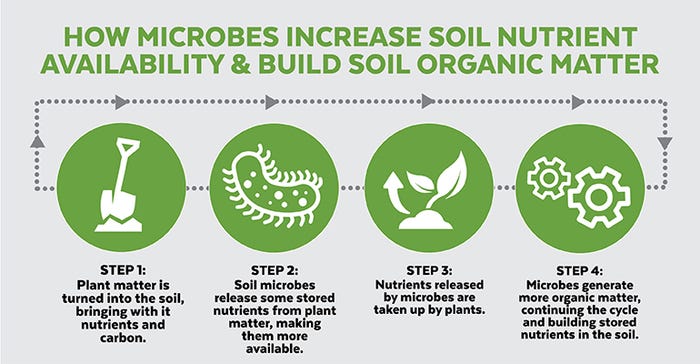May 1, 2017

Sponsored Content
When formulating a fertility plan, growers take many factors into consideration. These may include crop removal, soil tests, yield goals, cropping rotations and more. The process can be complex, especially since some of the largest impacts on crop performance – weather and soil health – are challenging to manage, at best. What recent soil science has taught us, however, is that soil health is a key driver of fertility and profitability. While growers cannot plan for floods or drought, good soil management can help all farms improve soil health, nutrient efficiency and plant uptake.
Fertilizer Solubility & Availability
In most states, NPK crop fertilizers are labeled using the percentage of total available nutrients in blends. This is the percentage of applied nutrients that are water-soluble, and immediately plant-available, upon application. Soluble nutrients are necessary to support early crop growth and yield potential, but additional nutrients are also needed throughout the season to maximize crop yield potential.
“When we apply nutrients in soluble forms to the soil, the risk of nutrient loss and leaching increases,” said Craig Dick, Director of Wholesale at Midwestern BioAg. “However, what we’ve learned is that soil management with a focus on improving soil life and structure can help us capture more applied nutrients and boost profitability.”
When fields are managed for optimal soil conditions, soil porosity and aggregation improve. These are the conditions that allow beneficial soil life to flourish. “Deep tillage and harsh crop inputs can damage soil life,” said Dick. “When this occurs, we miss the opportunity to use soil microbes to our benefit.”

Soil Organic Matter: Your Nutrient Bank
Soils are often rich with nutrients stored within soil organic matter (SOM). Other nutrients can be bound to soil calcium, aluminum or iron, unavailable for plant uptake. Unlike soluble nutrients listed on fertilizer tags, these nutrients are not accessible to plants. However, when soil conditions allow for thriving microbial populations, microbes can cycle nutrients from organic matter into plant-available forms and release nutrients that are chemically bound within the soil.
“Think of soil organic matter as your farm’s nutrient bank,” said Dick. “Just like how bank tellers can deposit a personal check and return with cash, soil microbes can turn organic matter deposits into plant-available nutrients. Banks are only as good as their systems and staff. Soil works much the same way.”
Emerging Research Suggests Microbes Build Soil Organic Matter
It’s well understood that when present, soil microbes break down SOM and release valuable crop nutrients. However, emerging research indicates that the relationship between SOM and microbes may be more complex than previously thought. “Established soil science suggests soil organic matter is formed from decaying plants and residues,” said Dick. “However, recent findings from the University of New Hampshire show organic matter is formed as microbes breakdown plant residues – not directly formed from plants residues themselves.”
In the study, soil microbes generated SOM in the absence of plant residues. Even when fed only table sugar, SOM created by microbes was nearly identical to naturally formed SOM from the field.
“This research may revolutionize how farmers build organic matter, and stored nutrients, in their soils,” said Dick. “However, many of the same management practices that build organic matter also support soil life. When we focus on preserving and rebuilding soils through reduced tillage and careful input selection, healthy soils will follow.”
Research will continue to build on the industry’s understanding of soil health, but the benefits of healthy soils remain the same. When soils are managed for optimal soil conditions, growers can optimize SOM formation, crop yields and plant resiliency.
About the Author(s)
You May Also Like




